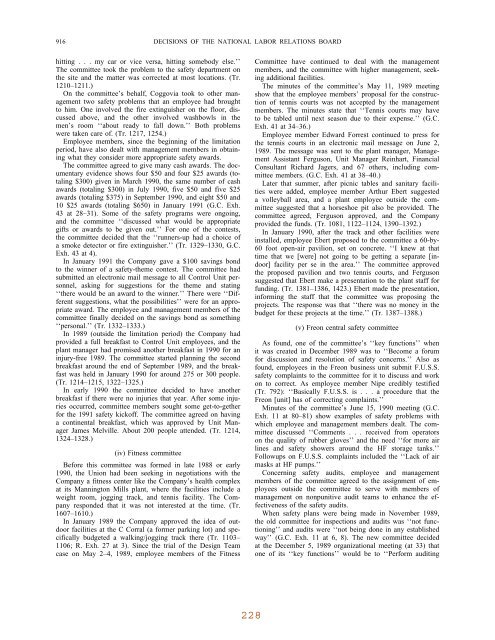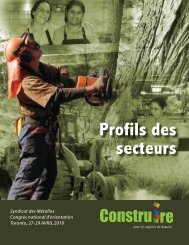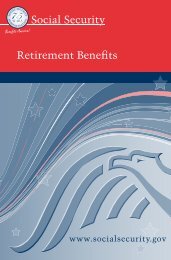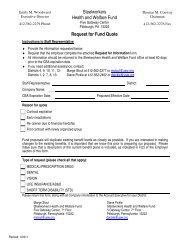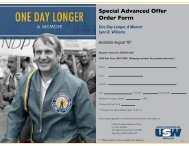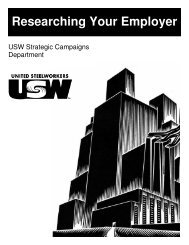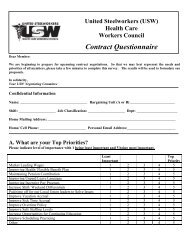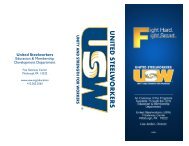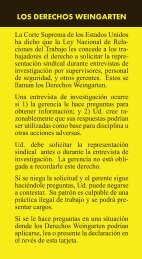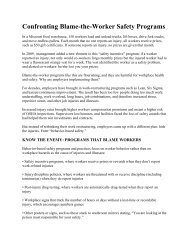Union Approach to Health and Safety: - United Steelworkers
Union Approach to Health and Safety: - United Steelworkers
Union Approach to Health and Safety: - United Steelworkers
You also want an ePaper? Increase the reach of your titles
YUMPU automatically turns print PDFs into web optimized ePapers that Google loves.
916 DECISIONS OF THE NATIONAL LABOR RELATIONS BOARD<br />
hitting . . . my car or vice versa, hitting somebody else.’’<br />
The committee <strong>to</strong>ok the problem <strong>to</strong> the safety department on<br />
the site <strong>and</strong> the matter was corrected at most locations. (Tr.<br />
1210–1211.)<br />
On the committee’s behalf, Coggovia <strong>to</strong>ok <strong>to</strong> other management<br />
two safety problems that an employee had brought<br />
<strong>to</strong> him. One involved the fire extinguisher on the floor, discussed<br />
above, <strong>and</strong> the other involved washbowls in the<br />
men’s room ‘‘about ready <strong>to</strong> fall down.’’ Both problems<br />
were taken care of. (Tr. 1217, 1254.)<br />
Employee members, since the beginning of the limitation<br />
period, have also dealt with management members in obtaining<br />
what they consider more appropriate safety awards.<br />
The committee agreed <strong>to</strong> give many cash awards. The documentary<br />
evidence shows four $50 <strong>and</strong> four $25 awards (<strong>to</strong>taling<br />
$300) given in March 1990, the same number of cash<br />
awards (<strong>to</strong>taling $300) in July 1990, five $50 <strong>and</strong> five $25<br />
awards (<strong>to</strong>taling $375) in September 1990, <strong>and</strong> eight $50 <strong>and</strong><br />
10 $25 awards (<strong>to</strong>taling $650) in January 1991 (G.C. Exh.<br />
43 at 28–31). Some of the safety programs were ongoing,<br />
<strong>and</strong> the committee ‘‘discussed what would be appropriate<br />
gifts or awards <strong>to</strong> be given out.’’ For one of the contests,<br />
the committee decided that the ‘‘runners-up had a choice of<br />
a smoke detec<strong>to</strong>r or fire extinguisher.’’ (Tr. 1329–1330, G.C.<br />
Exh. 43 at 4).<br />
In January 1991 the Company gave a $100 savings bond<br />
<strong>to</strong> the winner of a safety-theme contest. The committee had<br />
submitted an electronic mail message <strong>to</strong> all Control Unit personnel,<br />
asking for suggestions for the theme <strong>and</strong> stating<br />
‘‘there would be an award <strong>to</strong> the winner.’’ There were ‘‘Different<br />
suggestions, what the possibilities’’ were for an appropriate<br />
award. The employee <strong>and</strong> management members of the<br />
committee finally decided on the savings bond as something<br />
‘‘personal.’’ (Tr. 1332–1333.)<br />
In 1989 (outside the limitation period) the Company had<br />
provided a full breakfast <strong>to</strong> Control Unit employees, <strong>and</strong> the<br />
plant manager had promised another breakfast in 1990 for an<br />
injury-free 1989. The committee started planning the second<br />
breakfast around the end of September 1989, <strong>and</strong> the breakfast<br />
was held in January 1990 for around 275 or 300 people.<br />
(Tr. 1214–1215, 1322–1325.)<br />
In early 1990 the committee decided <strong>to</strong> have another<br />
breakfast if there were no injuries that year. After some injuries<br />
occurred, committee members sought some get-<strong>to</strong>-gether<br />
for the 1991 safety kickoff. The committee agreed on having<br />
a continental breakfast, which was approved by Unit Manager<br />
James Melville. About 200 people attended. (Tr. 1214,<br />
1324–1328.)<br />
(iv) Fitness committee<br />
Before this committee was formed in late 1988 or early<br />
1990, the <strong>Union</strong> had been seeking in negotiations with the<br />
Company a fitness center like the Company’s health complex<br />
at its Manning<strong>to</strong>n Mills plant, where the facilities include a<br />
weight room, jogging track, <strong>and</strong> tennis facility. The Company<br />
responded that it was not interested at the time. (Tr.<br />
1607–1610.)<br />
In January 1989 the Company approved the idea of outdoor<br />
facilities at the C Corral (a former parking lot) <strong>and</strong> specifically<br />
budgeted a walking/jogging track there (Tr. 1103–<br />
1106; R. Exh. 27 at 3). Since the trial of the Design Team<br />
case on May 2–4, 1989, employee members of the Fitness<br />
Committee have continued <strong>to</strong> deal with the management<br />
members, <strong>and</strong> the committee with higher management, seeking<br />
additional facilities.<br />
The minutes of the committee’s May 11, 1989 meeting<br />
show that the employee members’ proposal for the construction<br />
of tennis courts was not accepted by the management<br />
members. The minutes state that ‘‘Tennis courts may have<br />
<strong>to</strong> be tabled until next season due <strong>to</strong> their expense.’’ (G.C.<br />
Exh. 41 at 34–36.)<br />
Employee member Edward Forrest continued <strong>to</strong> press for<br />
the tennis courts in an electronic mail message on June 2,<br />
1989. The message was sent <strong>to</strong> the plant manager, Management<br />
Assistant Ferguson, Unit Manager Reinhart, Financial<br />
Consultant Richard Jagers, <strong>and</strong> 67 others, including committee<br />
members. (G.C. Exh. 41 at 38–40.)<br />
Later that summer, after picnic tables <strong>and</strong> sanitary facilities<br />
were added, employee member Arthur Ebert suggested<br />
a volleyball area, <strong>and</strong> a plant employee outside the committee<br />
suggested that a horseshoe pit also be provided. The<br />
committee agreed, Ferguson approved, <strong>and</strong> the Company<br />
provided the funds. (Tr. 1081, 1122–1124, 1390–1392.)<br />
In January 1990, after the track <strong>and</strong> other facilities were<br />
installed, employee Ebert proposed <strong>to</strong> the committee a 60-by-<br />
60 foot open-air pavilion, set on concrete. ‘‘I knew at that<br />
time that we [were] not going <strong>to</strong> be getting a separate [indoor]<br />
facility per se in the area.’’ The committee approved<br />
the proposed pavilion <strong>and</strong> two tennis courts, <strong>and</strong> Ferguson<br />
suggested that Ebert make a presentation <strong>to</strong> the plant staff for<br />
funding. (Tr. 1381–1386, 1423.) Ebert made the presentation,<br />
informing the staff that the committee was proposing the<br />
projects. The response was that ‘‘there was no money in the<br />
budget for these projects at the time.’’ (Tr. 1387–1388.)<br />
(v) Freon central safety committee<br />
As found, one of the committee’s ‘‘key functions’’ when<br />
it was created in December 1989 was <strong>to</strong> ‘‘Become a forum<br />
for discussion <strong>and</strong> resolution of safety concerns.’’ Also as<br />
found, employees in the Freon business unit submit F.U.S.S.<br />
safety complaints <strong>to</strong> the committee for it <strong>to</strong> discuss <strong>and</strong> work<br />
on <strong>to</strong> correct. As employee member Nipe credibly testified<br />
(Tr. 792): ‘‘Basically F.U.S.S. is . . . a procedure that the<br />
Freon [unit] has of correcting complaints.’’<br />
Minutes of the committee’s June 15, 1990 meeting (G.C.<br />
Exh. 11 at 80–81) show examples of safety problems with<br />
which employee <strong>and</strong> management members dealt. The committee<br />
discussed ‘‘Comments . . . received from opera<strong>to</strong>rs<br />
on the quality of rubber gloves’’ <strong>and</strong> the need ‘‘for more air<br />
lines <strong>and</strong> safety showers around the HF s<strong>to</strong>rage tanks.’’<br />
Followups on F.U.S.S. complaints included the ‘‘Lack of air<br />
masks at HF pumps.’’<br />
Concerning safety audits, employee <strong>and</strong> management<br />
members of the committee agreed <strong>to</strong> the assignment of employees<br />
outside the committee <strong>to</strong> serve with members of<br />
management on nonpunitive audit teams <strong>to</strong> enhance the effectiveness<br />
of the safety audits.<br />
When safety plans were being made in November 1989,<br />
the old committee for inspections <strong>and</strong> audits was ‘‘not functioning’’<br />
<strong>and</strong> audits were ‘‘not being done in any established<br />
way’’ (G.C. Exh. 11 at 6, 8). The new committee decided<br />
at the December 5, 1989 organizational meeting (at 33) that<br />
one of its ‘‘key functions’’ would be <strong>to</strong> ‘‘Perform auditing


